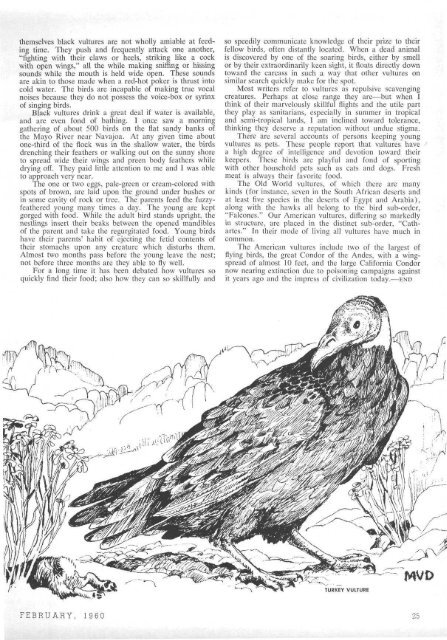Continued - Desert Magazine of the Southwest
Continued - Desert Magazine of the Southwest
Continued - Desert Magazine of the Southwest
Create successful ePaper yourself
Turn your PDF publications into a flip-book with our unique Google optimized e-Paper software.
<strong>the</strong>mselves black vultures are not wholly amiable at feeding<br />
time. They push and frequently attack one ano<strong>the</strong>r,<br />
"fighting with <strong>the</strong>ir claws or heels, striking like a cock<br />
with open wings," all <strong>the</strong> while making sniffing or hissing<br />
sounds while <strong>the</strong> mouth is held wide open. These sounds<br />
are akin to those made when a red-hot poker is thrust into<br />
cold water. The birds are incapable <strong>of</strong> making true vocal<br />
noises because <strong>the</strong>y do not possess <strong>the</strong> voice-box or syrinx<br />
<strong>of</strong> singing birds.<br />
Black vultures drink a great deal if water is available,<br />
and are even fond <strong>of</strong> bathing. I once saw a morning<br />
ga<strong>the</strong>ring <strong>of</strong> about 500 birds on <strong>the</strong> flat sandy banks <strong>of</strong><br />
<strong>the</strong> Mayo River near Navajoa. At any given time about<br />
one-third <strong>of</strong> <strong>the</strong> flock was in <strong>the</strong> shallow water, <strong>the</strong> birds<br />
drenching <strong>the</strong>ir fea<strong>the</strong>rs or walking out on <strong>the</strong> sunny shore<br />
to spread wide <strong>the</strong>ir wings and preen body fea<strong>the</strong>rs while<br />
drying <strong>of</strong>f. They paid little attention to me and I was able<br />
to approach very near.<br />
The one or two eggs, pale-green or cream-colored with<br />
spots <strong>of</strong> brown, are laid upon <strong>the</strong> ground under bushes or<br />
in some cavity <strong>of</strong> rock or tree. The parents feed <strong>the</strong> fuzzyfea<strong>the</strong>red<br />
young many times a day. The young are kept<br />
gorged with food. While <strong>the</strong> adult bird stands upright, <strong>the</strong><br />
nestlings insert <strong>the</strong>ir beaks between <strong>the</strong> opened mandibles<br />
<strong>of</strong> <strong>the</strong> parent and take <strong>the</strong> regurgitated food. Young birds<br />
have <strong>the</strong>ir parents' habit <strong>of</strong> ejecting <strong>the</strong> fetid contents <strong>of</strong><br />
<strong>the</strong>ir stomachs upon any creature which disturbs <strong>the</strong>m.<br />
Almost two months pass before <strong>the</strong> young leave <strong>the</strong> nest;<br />
not before three months are <strong>the</strong>y able to fly well.<br />
For a long time it has been debated how vultures so<br />
quickly find <strong>the</strong>ir food; also how <strong>the</strong>y can so skillfully and<br />
so speedily communicate knowledge <strong>of</strong> <strong>the</strong>ir prize to <strong>the</strong>ir<br />
fellow birds, <strong>of</strong>ten distantly located. When a dead animal<br />
is discovered by one <strong>of</strong> <strong>the</strong> soaring birds, ei<strong>the</strong>r by smell<br />
or by <strong>the</strong>ir extraordinarily keen sight, it floats directly down<br />
toward <strong>the</strong> carcass in such a way that o<strong>the</strong>r vultures on<br />
similar search quickly make for <strong>the</strong> spot.<br />
Most writers refer to vultures as repulsive scavenging<br />
creatures. Perhaps at close range <strong>the</strong>y are—but when I<br />
think <strong>of</strong> <strong>the</strong>ir marvelously skillful flights and <strong>the</strong> utile part<br />
<strong>the</strong>y play as sanitarians, especially in summer in tropical<br />
and semi-tropical lands, I am inclined toward tolerance,<br />
thinking <strong>the</strong>y deserve a reputation without undue stigma.<br />
There are several accounts <strong>of</strong> persons keeping young<br />
vultures as pets. These people report that vultures have<br />
a high degree <strong>of</strong> intelligence and devotion toward <strong>the</strong>ir<br />
keepers. These birds are playful and fond <strong>of</strong> sporting<br />
with o<strong>the</strong>r household pets such as cats and dogs. Fresh<br />
meat is always <strong>the</strong>ir favorite food.<br />
The Old World vultures, <strong>of</strong> which <strong>the</strong>re are many<br />
kinds (for instance, seven in <strong>the</strong> South African deserts and<br />
at least five species in <strong>the</strong> deserts <strong>of</strong> Egypt and Arabia),<br />
along with <strong>the</strong> hawks all belong to <strong>the</strong> bird sub-order,<br />
"Falcones." Our American vultures, differing so markedly<br />
in structure, are placed in <strong>the</strong> distinct sub-order, "Cathartes."<br />
In <strong>the</strong>ir mode <strong>of</strong> living all vultures have much in<br />
common.<br />
The American vultures include two <strong>of</strong> <strong>the</strong> largest <strong>of</strong><br />
flying birds, <strong>the</strong> great Condor <strong>of</strong> <strong>the</strong> Andes, with a wingspread<br />
<strong>of</strong> almost 10 feet, and <strong>the</strong> large California Condor<br />
now nearing extinction due to poisoning campaigns against<br />
it years ago and <strong>the</strong> impress or civilization today.—END<br />
TURKEY VULTURE<br />
FEBRUARY, 1960 25<br />
MVD<br />
f-

















